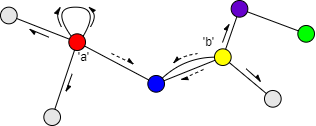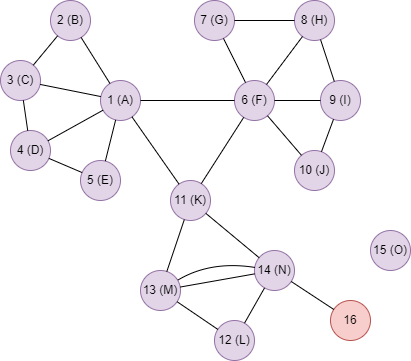Overview
Label Propagation Algorithm (LPA) is a community detection algorithm based on label propagation; it is an iterative process of nodes aggregation with the goal of label distribution stabilization. Although the results of the algorithm have a certain degree of randomness, it is very suitable for large complex networks which owes to its low time complexity and no need to specify the number of communities in advance. It is often included in the benchmark testing report in both academia and industry.
Related material of the algorithm:
- U.N. Raghavan, R. Albert, S. Kumara, Near linear time algorithm to detect community structures in large-scale networks (2007)
Basic Concept
Label
Label is the value of a specified property of node. Label can be propagated to the 1-step neighbors of the node, nodes with label can adopt label from its 1-step neighbors. When detecting the communities, label represents the community of the node, the propagation of label is the expansion of the community.

Consider the propagation of label a and b of the red and yellow nodes in the graph above:
- Blue node is the common neighbor of the two nodes, it will decide which label to adopt based on the weight of label
aandb, or to adopt both labels if it is allowed. - Red node has self-loop edge, so label
aalso propagates to itself. - Label
bcannot propagate to the green node during one round of propagation; if the purple node (green node's only neighbor) adopts labelb, the green node will adopt labelbduring the next round of propagation.
Ultipa's LPA supports full label propagation, that is, all initial labels are valid and able to propagate. In case there is a need to specify part of the labels as valid, please contact Ultipa team for algorithm customization.
Label Probability
If a node can only adopt only one label from its neighbors, it is called single-label propagation, while if multiple labels are allowed to adopt, it is called multi-label propagation.
In multi-label propagation, after a node adopts multiple labels, each label will be given a probability which is proportional to the label weight, and the sum of all label probabilities of a node equals to 1. For single-label propagation, the case is much easier as the node's only label takes a probability of 1.
For example, if a node only adopts one label, the label probability is 1; if it adopts labels a and b with weights 1.5 and 1 respectively, the probabilities of a and b are 1.5/(1+1.5) = 0.6 and 1/(1+1.5) = 0.4 respectively.
Label Weight
Node j has label l, when it propagates to its neighbor node i, the weight of label l equals to the product of the probability of l, the weight of j, and the total weight of all edges between i and j; when i has multiple neighbor nodes with label l, the weight of each l needs to be summed:

where j is any neighbor node of i that has label l , p(l) is the probability of l, w(j) is the weight of j, A(ij) is the total weight of all edges between i and j.
It is needed to specify a numeric property of node as node weight, and a numeric property of edge as edge weight.
Label Adoption
The principle of label adoption is to keep the top one or several labels with the largest weights among the neighbor labels, and to calculate the label probabilities. When some labels have the same probabilities which affects the adoption decision, the system would select randomly from these parallel labels.
For any node i in the graph, l is the neighbor label of i, w(l) is the weight of l, the new label l of i can be denoted as:

As mentioned previously, under the circumstances of multi-label propagation, the algorithm normalizes the label weight, that is, converts label weight into a weight probability.
When the algorithm begins, initial labels are assigned to nodes based on the algorithm parameters; during each iteration, it calculates for each node whether there is any label different from its current labels can be adopted from its neighbors, and after all nodes are calculated, updates the nodes which can adopt new labels. Iterating and looping by this rule until no node could adopt new labels, or the number of iterations reaches the limit.
Ultipa's LPA follows the synchronous update principle when updating node labels, the algorithm has a corresponding interrupt mechanism against the label oscillations (mostly found in bipartite graph) that might occur.
Special Case
Lonely Node, Disconnected Graph
For disconnected graph, there is no edge between its lonely nodes and connected components to propagate labels, connected components do not contain the same initial labels will not be divided into the same community.
Self-loop Edge
LPA treats the self-loop edge in the same way with the Degree algorithm algo(degree), which counts each self-loop edge twice.
Directed Edge
For directed edges, LPA ignores the direction of edges but calculates them as undirected edges.
Results and Statistics
Run LPA in the graph below, all node and edge weights are 1, the letter wrote in the node is the initial label of node, node 16 has no label, the algorithm iterates 5 rounds:

Algorithm results 1: Keep maximum one label for each node, return _uuid, label_1 and probability_1
| _uuid | label_1 | probability_1 |
|---|---|---|
| 1 | C | 1.000000 |
| 2 | C | 1.000000 |
| 3 | C | 1.000000 |
| 4 | C | 1.000000 |
| 5 | C | 1.000000 |
| 6 | H | 1.000000 |
| 7 | H | 1.000000 |
| 8 | H | 1.000000 |
| 9 | H | 1.000000 |
| 10 | H | 1.000000 |
| 11 | N | 1.000000 |
| 12 | N | 1.000000 |
| 13 | N | 1.000000 |
| 14 | N | 1.000000 |
| 15 | O | 1.000000 |
| 16 |
Algorithm statistics 1: Number of labels label_count
| label_count |
|---|
| 4 |
Algorithm results 2: Keep maximum two labels for each node, return _uuid, label_1, probability_1, label_2 and probability_2
| _uuid | label_1 | probability_1 | label_2 | probability_2 |
|---|---|---|---|---|
| 1 | C | 0.705578 | A | 0.294422 |
| 2 | C | 0.658854 | A | 0.341145 |
| 3 | A | 0.508263 | C | 0.491737 |
| 4 | C | 0.688864 | E | 0.311136 |
| 5 | A | 0.572178 | C | 0.427822 |
| 6 | H | 0.723903 | A | 0.276097 |
| 7 | H | 0.797693 | I | 0.202307 |
| 8 | H | 0.645654 | I | 0.354346 |
| 9 | H | 0.779780 | A | 0.220220 |
| 10 | H | 0.617815 | I | 0.382185 |
| 11 | N | 0.611782 | M | 0.388218 |
| 12 | N | 0.611782 | M | 0.388218 |
| 13 | N | 0.766861 | M | 0.233139 |
| 14 | N | 0.663694 | M | 0.336306 |
| 15 | O | 1.000000 | ||
| 16 |
Algorithm statistics 2: Number of labels label_count
| label_count |
|---|
| 8 |
Command and Configuration
- Command:
algo(lpa) - Configurations for the parameter
params():
| Name | Type | Default |
Specification | Description |
|---|---|---|---|---|
| node_label_property | @<schema>.<property> |
/ | Numeric or string class node property, LTE needed | Name of the node schema and property as label; node without this property will not participate in the calculation; random number is used as label if not set |
| node_weight_property | @<schema>.<property> |
/ | Numeric node property, LTE needed | Name of the node schema and property as node weight; node without this property will not participate in the calculation; weight is 1 if not set |
| edge_weight_property | @<schema>.<property> |
/ | Numeric edge property, LTE needed | Name of the edge schema and property as edge weight; edge without this property will not participate in the calculation; weight is 1 if not set |
| k | int | 1 | >=1 | The maximum number of labels each node can keep; labels are ordered by probability |
| loop_num | int | 5 | >=1 | Number of iterations |
Example: Run LPA, label locates on node property @default.name, iterate 5 rounds and keep no more than two labels for each node
algo(lpa).params({
node_label_property: @default.name,
k: 2,
loop_num: 5
}) as a,b return a,b
Algorithm Execution
Task Writeback
1. File Writeback
Configuration |
Data in Each Row |
|---|---|
| filename | _id,label_1,probability_1,...label_k,probability_k |
Example: Run LPA, label locates on node property @default.name, iterate 5 rounds and keep no more than two labels for each node, write the algorithm results back to file named lpa
algo(lpa).params({
node_label_property: @default.name,
k: 2,
loop_num: 5
}).write({
file:{
filename: "lpa"
}
})
2. Property Writeback
Configuration |
Writeback Content | Type |
Data Type |
|---|---|---|---|
| property | label_1, probability_1, ... label_k, probability_k |
Node property | Data type of label is string, data type of label probability is float |
Example: Run LPA, label locates on node property @default.name, iterate 5 rounds and keep no more than two labels for each node, write the algorithm results back to node properties named newName_1, probability_1, newName_2 and probability_2
algo(lpa).params({
node_label_property: @default.name,
k: 2,
loop_num: 5
}).write({
db:{
property: "newName"
}
})
3. Statistics Writeback
| Name | Data Type | Description |
|---|---|---|
label_count |
int | Number of labels |
The number of labels means the number of labels left after the algorithm is finished; when k = 1, since each node only keeps one label, the number of labels is the number of communities.
Example: Run LPA, label locates on node property @default.name, iterate 5 rounds and keep no more than two labels for each node, write the algorithm statistics back to task information
algo(lpa).params({
node_label_property: @default.name,
k: 2,
loop_num: 5
}).write()
Direct Return
Alias Ordinal |
Type |
Description | Column Name |
|---|---|---|---|
| 0 | []perNode | Node and its label, label probability | _uuid, label_1, probability_1, ... label_k, probability_k |
| 1 | KV | Number of labels | label_count |
Example: Run LPA, label locates on node property @default.name, iterate 5 rounds and keep no more than one label for each node, define algorithm results and statistics as aliases named results and count, and return the results and statistics
algo(lpa).params({
node_label_property: @default.name,
k: 1
}) as results, count
return results, count
Streaming Return
Alias Ordinal |
Type |
Description | Column Name |
|---|---|---|---|
| 0 | []perNode | Node and its label, label probability | _uuid, label_1, probability_1, ... label_k, probability_k |
Example: Run LPA, label locates on node property @default.name, iterate 5 rounds and keep no more than one label for each node, and return the results ordered by the ascending label name and node UUID
algo(lpa).params({
node_label_property: @default.name,
k: 1,
loop_num: 5
}).stream() as lpa
return lpa order by lpa.label_1, lpa._uuid
Real-time Statistics
Alias Ordinal |
Type |
Description | Column Name |
|---|---|---|---|
| 0 | KV | Number of labels | label_count |
Example: Run LPA, label locates on node property @default.name, iterate 5 rounds and keep no more than one label for each node, and return the number of communities
algo(lpa).params({
node_label_property: @default.name,
k: 1,
loop_num: 5
}).stats() as count
return count
Consistency of Results
Affected by factors such as the order of nodes, the random selection of labels with the same weights, the parallel calculation and so on, the community division results of LPA may be different.

